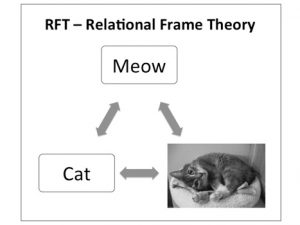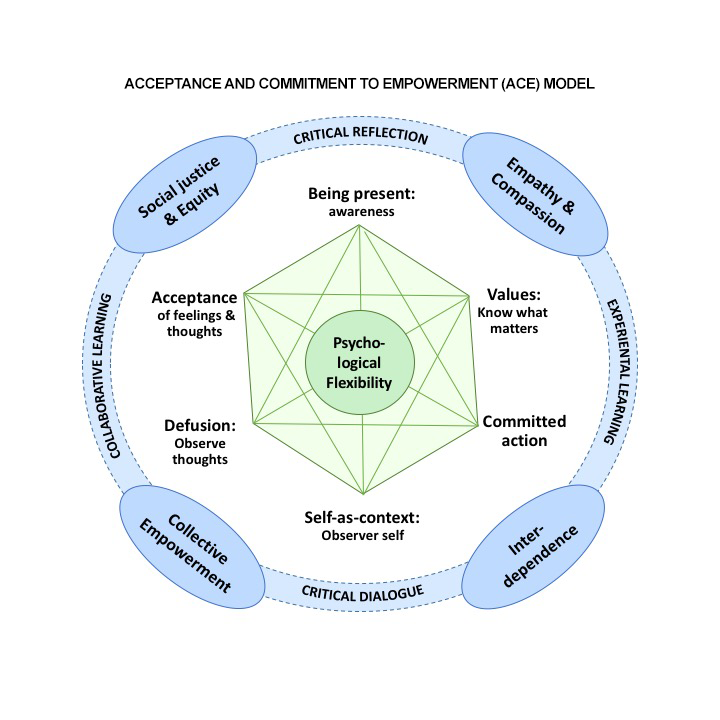Session 1: Introduction to ACE – Being Present & Defusion
1.5 CHAMPs-In-Action theoretical Model
Learning Objectives:
- To introduce the theoretical concepts of Acceptance and Commitment to Empowerment Training (ACE)
- To enhance participants’ understanding of how the integrated model of ACE contributes to psychological flexibility and collective empowerment
Materials: Projector, Laptop, Video on the ACE model, Handouts 1.5.1 and 1.5.2 – CHAMPs-In-Action Theoretical Model
Time Required: 40 Minutes
Activities & Instructions
Instructions to Participants
- Facilitator says, “We are now going to show you a short video on the theories and concepts used to guide our CHAMP intervention. We also have a handout that we will give you after we finish watching the video.”
- After showing the video, Facilitator debriefs by saying,
- “What are the key concepts that you have learned from this video?”
- “How are some of these concepts relevant to you?”
- “Does anyone have any questions?”
Notes to Facilitators
- Provide each participant Handouts 1.5.1 and 1.5.2
- Prepare a set of ACE Model – Handout 1.5.2 (one per participant and facilitator) and place each in a plastic sheet protector to be used during training.
- Provide the protected ACE model sheets to participants at the beginning of each session and collect them at the end of each session.
- Use the ACE Model during debriefing of each learning activity to illustrate and reinforce learning about the meaning of each concept of the ACE Model.
Key Summary Points
The CHAMP intervention was successful because:
- it combined strategies that promote psychological flexibility as well as empowerment education.
- it was community-driven and it exemplified GIPA/MIPA, social justice, and collective empowerment principles.
Handout 1.5.1 – Acceptance Commitment to Empowerment Model
Drawing on insights and evidence from the CHAMP Study, we have integrated ACT and SJCB into a holistic model – Acceptance and Commitment to Empowerment (ACE).
What is ACT?
ACT (pronounced as one) refers to Acceptance and Commitment Therapy/ Training. In a nutshell, ACT consists of three steps (Eifert & Forsyth, 2005):
- Accept our thoughts and feelings, including the unwanted ones (anxiety, guilt, pain, sense of inadequacy), by letting go of our struggle with them and recognizing them for what they are – our thoughts and feelings.
- Choose our directions in life by identifying and focusing on what really matters to us and what we truly value in life.
- Take action to realize our valued life goal, or what matters to us based on our personal and collective values, and how to live a meaningful and engaging life.
Our ability to make arbitrary connections: A blessing and a curse?
Human beings have the ability to make complex and arbitrary connections between “things” – objects, symbols, representations, aspects of the world – regardless of whether the things are in front of us or not. For instance, most English-speaking people in Canada are able to associate the word ‘meow’ with the word ‘cat’ and an image of a cat in their mind without the actual presence of a cat in their immediate environment.
This ability of applying a relational frame to everything we experience has enabled humans to innovate. At the same time, it has also led to psychological struggles when we are not able to recognize our thoughts as thoughts, or feelings as feelings. We suffer psychologically when we are fused with ideas, thoughts, or unworkable rules and treat them as the absolute truth or reality. For example, we suffer when we are not able to differentiate between ‘I am too skinny’ as a thought and ‘I am too skinny’ as a fused self-concept.
ACT promotes our awareness that:
- we have non-stop judgmental thoughts based on norms and social rules that we have internalized;
- we spend a lot of time thinking about and trying to avoid uncomfortable feelings and unwanted thoughts;
- our avoidance tends to worsen our psychological struggles, e.g., when people keep telling themselves not to be anxious, they tend to become more anxious;
- accepting thoughts and feelings that emerge beyond our control helps to reduce our suffering;
- learning new ways to relate to these thoughts and feelings may free us from being stuck; and
- developing compassion towards ourselves and others often leads us to living fully;
- no thoughts are inherently problematic; it all depends on the context and function of these thoughts; for example, when we are fused with the thought or idea that “life is harsh,” we may retreat and live in isolation. When we are defused from the thought or idea that harsh life is the only reality, we are able to recognize other possibilities in life, e.g., life is creative; life is filled with caring people; experiencing joy is possible even when life seems harsh, etc. and engage in value-guided and fulfilling living.
Source:
Forsyth, J. P., & Eifert, G. H. (2007). The mindfulness & acceptance workbook for anxiety: A guide to breaking free from anxiety, phobias & worry using Acceptance & Commitment Therapy. New Harbinger Publications.
What is SJCB?
SJCB stands for Social Justice Capacity Building, which uses a capacity building approach to address stigma and social inequities. SJCB are underpinned by four interrelated core principles and values: social justice and equity; empathy and compassion; interdependence or interconnectedness, and collective empowerment. The goals of SJCB are to support participants to recognize human interdependence, individual and collective resilience, and the possibilities for human flourishing when we work together to advocate for social justice and equity.
SJCB engages participants in four processes:
- experiential learning that engages participants as holistic beings and honor their embodied knowledge and lived experiences
- critical reflection that enables participants to recognize the impact of how stigma creates fear, self-blame and shame that in turn reinforce structural oppression and domination
- critical dialogue that supports participants to develop empathy and compassion for themselves and others, and through the process become empowered and motivated to take committed action for social justice
- collaborative learning that promote shared creativity, innovations, and commitment to address social exclusion and health disparities
 In CHAMPs-In-Action, ACT and SJCB are integrated into the Acceptance and Commitment to Empowerment (ACE) model to promote psychological flexibility and collective empowerment
In CHAMPs-In-Action, ACT and SJCB are integrated into the Acceptance and Commitment to Empowerment (ACE) model to promote psychological flexibility and collective empowerment
ACE learning strategies include: experiential activities that enable participants to let go of rules and stories that perpetuate stigma and get them stuck, interactive activities that facilitate critical understanding of structure violence, and collaborative learning that enable them to develop collective goals and support each other to become HIV and social justice champions.
Source:
- Li, A., & Wong, J. P. (2016). CHAMP: Mobilizing people living with HIV and allies to champion HIV prevention and care in ethno-racial communities. Prevention in Focus: Spotlights on Programming and Research, Fall 2016 (Published by CATIE). Available: https://www.catie.ca/en/news/catie-exchange/2016-08-10
- ACT Hexaflex diagram adapted from: Luoma, J. B., Hayes, S. C., & Walser, R. D. (2017). Learning ACT: An acceptance and commitment therapy skills training manual for therapists (2nd ed.). Context Press, an imprint of New Harbinger Publications, Inc.
Handout 1.5.2(A) – ACE Diagram (Side A) – Psychological Inflexibility

Handout 1.5.2 (B) – ACE Diagram (Side B) – Acceptance and Commitment to Empowerment (ACE) Model

Source:
- Li, A., & Wong, J. P. (2016). CHAMP: Mobilizing people living with HIV and allies to champion HIV prevention and care in ethno-racial communities. Prevention in Focus: Spotlights on Programming and Research, Fall 2016 (Published by CATIE). Available: https://www.catie.ca/en/news/catie-exchange/2016-08-10
- ACT Hexaflex diagram adapted from: Luoma, J. B., Hayes, S. C., & Walser, R. D. (2017). Learning ACT: An acceptance and commitment therapy skills training manual for therapists (2nd ed.). Context Press, an imprint of New Harbinger Publications, Inc.

